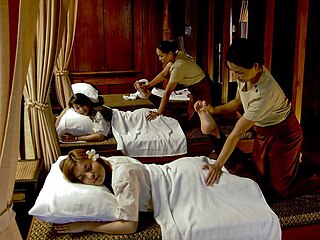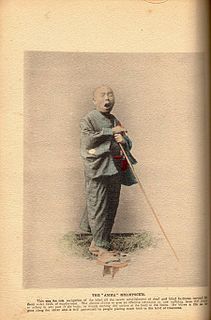
Massage is the manipulation of the body's soft tissues. Massage techniques are commonly applied with hands, fingers, elbows, knees, forearms, feet, or a device. The purpose of massage is generally for the treatment of body stress or pain. A person professionally trained to give massages is traditionally known as a masseur (male) or a masseuse (female). In the United States, the title massage therapist has been recognized as a business norm for those who have been professionally trained to give massages.

Shiatsu is a form of Japanese bodywork based on concepts in traditional Chinese medicine such as the use of chi meridians. Shiatsu derives from a Japanese massage modality called anma.
Rolfing is a form of alternative medicine originally developed by Ida Rolf (1896–1979) as Structural Integration. It is typically delivered as a series of ten hands-on physical manipulation sessions sometimes called "the recipe". It is based on Rolf's ideas about how the human body's "energy field" can benefit when aligned with the Earth's gravitational field. Practitioners combine superficial and deep manual therapy with movement prompts. The process is sometimes painful. It is not known whether Rolfing is safe.

Tui na is a branch of Traditional Chinese Medicine and as such is often used in conjunction with acupuncture, moxibustion, fire cupping, Chinese herbalism, t'ai chi or other Chinese internal martial arts, and qigong.and wuxingheqidao

Thai massage or Thai yoga massage is a traditional healing system combining acupressure, Indian Ayurvedic principles, and assisted yoga postures. The idea of Shen-lines alias energy-lines was first used is "Thai yoga massage". These are similar to nadis as per the philosophy of yoga by Gorakhnath.
Manual therapy, or manipulative therapy, is a physical treatment primarily used by physical therapists, physiotherapists, occupational therapists to treat musculoskeletal pain and disability; it mostly includes kneading and manipulation of muscles, joint mobilization and joint manipulation. It's also used by massage therapists, athletic trainers, osteopaths, and physicians
Myofascial trigger points, also known as trigger points, are described as hyperirritable spots in the skeletal muscle. They are associated with palpable nodules in taut bands of muscle fibers. They are a topic of ongoing controversy, as there is limited data to inform a scientific understanding of the phenomenon. Accordingly, a formal acceptance of myofascial "knots" as an identifiable source of pain is more common among bodyworkers, physical therapists, chiropractors, and osteopathic practitioners. Nonetheless, the concept of trigger points provides a framework which may be used to help address certain musculoskeletal pain.
Lomilomi In the Hawaiian and Samoan language, the word used traditionally, called lomi, means "to knead, to rub, or soothe; to work in and out, as the paws of a contented cat." It may also mean "to take and turn, to shift" as in "the sacred shift within you that is inspired by the healing kahuna..." said twice "lomilomi" for emphasis.
Myofascial release is an alternative medicine therapy claimed to be useful for treating skeletal muscle immobility and pain by relaxing contracted muscles, improving blood, oxygen, and lymphatic circulation, and stimulating the stretch reflex in muscles.

The stone massage is a form of alternative medicine massage therapy and bodywork involving the placement of a number of either heated or cooled stones to the body for the purpose of pain relief, relaxation and therapy. There are a manifold of variations and techniques used in the application of stone massage therapy, deriving from a variety of traditional practices. Stone massages are primarily used to alleviate physical pain issues, however, are also used to promote emotional and spiritual wellbeing in practice.

Anma refers to both a practice of traditional Japanese massage and to practitioners of that art. Modern shiatsu is largely derived from anma.

Equine massage is the practice of massage on horses. Beginning in the early 1990s, it has been a growing field of equine therapy, utilized for both day-to-day riding and post-trauma rehabilitation. Proponents list a number of positive effects, including the improvement of movement and the reduction of pain and stress responses. Scientific study is beginning to demonstrate possible benefits, although more study is needed.
Manual lymphatic drainage (MLD) is a type of massage based on the hypothesis that it will encourage the natural drainage of the lymph, which carries waste products away from the tissues back toward the heart. The lymph system depends on intrinsic contractions of the smooth muscle cells in the walls of lymph vessels (peristalsis) and the movement of skeletal muscles to propel lymph through the vessels to lymph nodes and then to the lymph ducts which return lymph to the cardiovascular system. Manual lymph drainage uses a specific amount of pressure and rhythmic circular movements to stimulate lymph flow. Clinical studies of MLD conclude that further study of the practice is required before recommending it as an effective health treatment.
Medical massage is outcome-based massage, primarily the application of a specific treatment targeted to the specific problem(s) the patient presents with a diagnosis and are administered after a thorough assessment/evaluation by the medical massage therapist with specific outcomes being the basis for treatment. It is also known as clinical massage or treatment massage.
Myotherapy is a form of physical therapy which focuses on the assessment, treatment and rehabilitation of musculoskeletal pain and associated pathologies. The term myotherapy was originally coined by Bonnie Prudden to describe a specific type of trigger point therapy which she developed in the 1970s based on the earlier work of Travell and Simons who researched the cause and treatment of pain arising from myofascial trigger points. While based on rational principles, there is little scientific research regarding the efficacy of this therapy, so it remains controversial within the medical and academic disciplines.

Physical therapy for canines adapts human physical therapy techniques to increase function and mobility of joints and muscles in animals. Animal rehabilitation can reduce pain and enhance recovery from injury, surgery, degenerative diseases, age-related diseases, and obesity.
Canine massage is a branch of massage therapy that promotes health in dogs. Specifically, canine massage therapy is a form of alternative therapy the benefits of which may include relaxation, increased oxygenation, relief from pain, improved joint flexibility, as well as miscellaneous benefits to the immune system. It uses touch to maintain or improve both physical and emotional well-being.
Watsu is a form of aquatic bodywork used for deep relaxation and passive aquatic therapy. Watsu is characterized by one-on-one sessions in which a practitioner or therapist gently cradles, moves, stretches, and massages a receiver in chest-deep warm water.
Harold Dull (1935-2019) was an American aquatic bodyworker and poet best known as the creator of Watsu, originally developed in the early 1980s at Harbin Hot Springs, California. He is also known for his poetry, as founder of the Worldwide Aquatic Bodywork Association (WABA), and as creator of Tantsu and Tantsuyoga. Watsu is a form of aquatic bodywork in which a practitioner or therapist gently cradles, moves, stretches, and massages a receiver in chest-deep warm water for deep relaxation and aquatic therapy.
John Harvey Kellogg wrote an extensive piece on concepts revolving around the topic of massage. In his work published in 1895 called The Art of Massage, he makes it a point to discuss the history of the field. Kellogg supported pushing the idea that massage can help stimulate muscles to prevent their degradation. Also, not one category was present where the number of muscles present in men was equal to the number in women.








